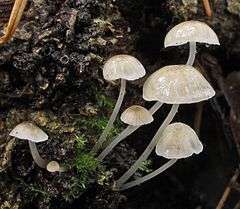Phloeomana
| Phloeomana | |
|---|---|
 | |
| Phloeomana speirea | |
| Scientific classification | |
| Kingdom: | Fungi |
| Division: | Basidiomycota |
| Class: | Agaricomycetes |
| Order: | Agaricales |
| Family: | Porotheleaceae |
| Genus: | Phloeomana Redhead (2013) |
| Type species | |
| Phloeomana speirea (Fr.) Redhead (2013) | |
| Species | |
|
P. alba | |
Phloeomana is a bark-inhabiting agaric fungal genus that produces fuscous-colored to whitish mycenoid to omphalinoid fruit bodies in temperate forests. In addition to the type species Phloeomana speirea,[1] 4 other species, P. alba,[2] P. clavata[3][4] (= M. thujina, M. phaeophylla), P. hiemalis[2][5][6] and P. minutula (formerly Mycena olida),[2] have been placed in the genus.[7][8][9] The genus is characterized by nonamyloid smooth, hyaline (translucent) basidiospores and tissues, poorly to moderately differentiated cheilocystidia, diverticulate pileipellis hyphae and general smooth stipe hyphae with scattered caulocystidia.[1] It is one of several mushroom genera formerly classified most recently in Mycena, Omphalina, Hydropus, or Marasmiellus. Phylogenetically, Phloeomana is distant from the Mycenaceae and is closest to a clade or group that includes other former members of Mycena now in Atheniella and Hemimycena clearly excluded from the Mycenaceae and tentatively classified in the Porotheleaceae.
Etymology
The name Phloeomana is an oblique reference to bark and phloem on which it grows and the oceanic term, 'mana' in reference to a being or spirit, hence a bark spirit.[1]
See also
References
- 1 2 3 Redhead SA. (2013). "Nomenclatural novelties" (PDF). Index Fungorum. 15: 1–2.
- 1 2 3 Maas Geesteranus RA (1991). "Conspectus of the Mycenas of the Northern Hemisphere - 15 Sections Hiemales and Exornatae". Proc. Kon. Ned. Akad. v. Wetensch. 94 (1): 81–102.
- ↑ Redhead SA (1986). "Mycological Observations 15-16 on Omphalia and Pleurotus". Mycologia. 78 (4): 522–528. doi:10.2307/3807763.
- ↑ Ronikier A, Aronsen A. (2007). "Type study of Mycena phaeophylla reveals its conspecificity with M. clavata". Mycologia. 99 (6): 924–935. doi:10.3852/mycologia.99.6.924.
- ↑ Maas Geesteranus RA (1979). "Three Mycenas revised". Persoonia. 10 (2): 277–282.
- ↑ Robich G. (2000). "Su una Mycena e una Mycenella". Rivista di Micologia. 43 (3): 237–247.
- ↑ Redhead SA. (2016a). "Nomenclatural novelties" (PDF). Index Fungorum. 289: 1.
- ↑ Redhead SA. (2016b). "Nomenclatural novelties" (PDF). Index Fungorum. 290: 1.
- ↑ Redhead SA. (2016c). "Nomenclatural novelties" (PDF). Index Fungorum. 291: 1.